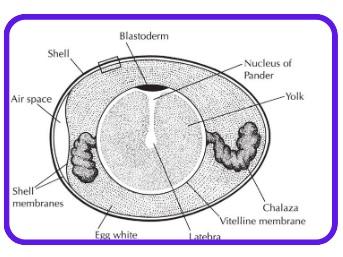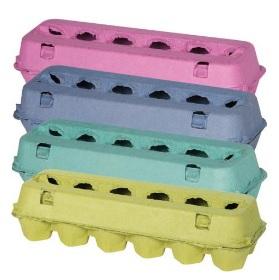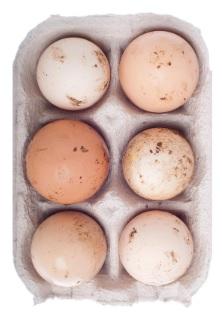Proper Handling for Safe Eggs
Published: April 10, 2024
By: Dr. Richard Blatchford, University of California, Davis. Reviewers: Dr. Shawna Weimer, University of Arkansas; Dr. Prafulla Regmi, University of Georgia; Dr. Marisa Erasmus, Purdue University.

The holiday season is once again here, which means many kitchens will be filling up with baked goods and savory dishes. It is also the time of year when the use of eggs increases for all of those delicious dishes! However, eggs can be a potential source of Salmonella bacteria that can cause illness or in rare cases even death. Here are some tips to help reduce that risk in your kitchen.
Eggs 101
The good news is that egg safety starts with the egg itself! Eggs come with some natural defenses against invasion by microbes like bacteria. When an egg is laid, it is covered with a thin layer of protein called a cuticle. This acts as a natural barrier against microbes. The egg shell itself also acts as a physical barrier. Inside the shell are two membranes that can also block the flow of contaminants to the inside of the egg. Finally, the albumen, or egg white, contains some anti-microbial proteins that help limit the growth of these invaders. While this is a pretty good natural start to egg safety, these measures are not fool proof, and microbes can bypass these defenses. Luckily there are some actions that can be taken to help further reduce the risk of egg contamination.

Egg Storage
If eggs are purchased from a store, they likely come in a carton, and should be stored in that carton once in your kitchen. Eggs bought were refrigerated should be promptly refrigerated. If the eggs warm too much, they will develop a layer of condensation, which can help microbes to enter the egg. The eggs should be maintained around 40 degrees Fahrenheit, which is a standard temperature for most refrigerators. The eggs should be stored on the internal shelves, and not on the door, as the opening of the door creates temperature fluctuations that can cause the eggs to warm. The cool temperature is important as it restricts the growth of any microbes that may have entered the eggs. If eggs are not refrigerated when bought, they do not need to be refrigerated, although cooling them will keep the eggs fresher for a longer period of time. At room temperature, eggs will remain at peak freshness for about one week.

What About Washing?
If the eggs were bought at a store, there is no need to wash them, as they have already been washed before packaging (it’s the law!).
If the eggs were freshly laid, you should not wash them before storing. Washing will remove the cuticle, potentially exposing the eggs to microbes. If a temperature gradient is created by using cold water for washing, the egg membranes will contract, causing a suction through the egg shell pores, which can pull any microbes on the surface of the egg inside.

My Egg Is Dirty!
Here are some suggestions if you find you have dirty eggs:
1. Try to dry clean the egg’s surface with a clean paper towel or hard bristle toothbrush dedicated to egg cleaning.
2. If you must wash eggs, wash right before use as this limits any time lag when microbe populations can grow. Do not soak eggs, as they can absorb the wash water along with any microbes.
3. Discard any very dirty or cracked eggs, as they are more likely to be contaminated with microbes.

Non-harmful Egg Characteristics
Sometimes eggs have oddities or look different than other eggs, and the safety of the eggs may be in question. Here are some causes of these differences that are not harmful.
Cloudy Egg Whites: This is caused by carbon dioxide in the albumen. Freshly laid eggs contain higher amounts of carbon dioxide, which decreases as the egg ages. Sometimes during the processing process, the pores in the egg shell are blocked, and the carbon dioxide can not escape.
Yellowish Egg Whites: This is caused by higher levels of riboflavin (vitamin B2).
Blood in Egg: If a small amount of blood (red dot or smear) if found in the egg, this is called a blood spot. This happens when there is bleeding along the hen’s reproductive tract, and a drop of blood is picked up by the egg before it is laid.
Tissue in Egg: Sometimes a small bit of tissue (often tan or dark in color) can be observed in the egg white. This is called a meat spot. Similar to blood spots, this is caused when a small bit of the hen’s reproduction tract tissue sloughs off and is incorporated into the egg.
Bumps on Eggshell: These are extra deposits of calcium when the eggshell was formed. Colored spots on the egg shell may also indicate accumulation of extra cuticle formation.
Egg Quality and Hen Welfare
Most of these non-harmful egg oddities are caused by a disruption during the egg formation process. These disruptions typically a natural hiccup in the reproduction system, or a symptom of a non-fully functional system (such as young birds or older hens). In these cases, the egg abnormalities are short lived, and may only be seen once. While a one-off abnormality is nothing to worry about, consistent changes in egg quality is typically a sign that a hen is experiencing poor welfare. Here are some common causes of egg abnormalities that can negatively impact a laying hen.
1. Poor nutrition: If hens are not getting the proper nutrition, such as adequate levels of calcium, water, protein, etc., egg formation will not work correctly. A commercial layer diet should always be fed to hens, as they are properly formulated to cover all of a hens nutritional needs. Heavy parasite loads can also cause nutritional deficiencies, as they absorb the host’s nutrients for themselves.
2. Disease: Respiratory disease, especially infectious bronchitis, can cause egg deformities to occur. These hens will likely also show other symptoms, such as swollen eyes/sinuses and leaky nares. These hens should be quarantined and veterinary care should be explored to help them through. Other diseases, such as ovarian cancer is common to see in older hens and will cause abnormalities or stop the egg formation process outright.
3. Stress: Stress is a major cause of egg deformities. This is often environmental stress, such as heat and cold stress, but can also be caused by attempted predation events, aggression from other hens, or rough handling by people. It is important to determine the cause of stress so that it can be removed properly and the eggs should eventually return to normal.
About 277 eggs per capita were consumed in the United States in 2022. Eggs are an excellent source of protein, unsaturated fatty acids, vitamins, and minerals. While there can be some risk of food borne illness associated with eggs, such as Salmonella, taking the steps described above can give consumers confidence that any risk has been greatly reduced. Egg condition can also be used as a metric of hen welfare with persistent abnormalities likely a sign of illness, stress, or nutritional deficiency.
This article was originally published on Poultry Extension Collaborative (PEC) and it is reproduced here with permission from the authors.
References
Further resources:
Egg Facts and Production Statistics:
https://unitedegg.com/facts-stats/
https://www.incredibleegg.org/
https://eggsafety.org/
Books:
Hester, P.Y. (ed.) 2016. Egg Innovations and Strategies For Improvements. Academic Press, United States.
Kashimori, A. 2017. The Illustrated Egg Handbook. Context Publishing, United Kingdom.
Related topics:
Related Questions
What are some natural defenses that eggs have against invasion by microbes?
Eggs come with some natural defenses against invasion by microbes like bacteria. When an egg is laid, it is covered with a thin layer of protein called a cuticle. This acts as a natural barrier against microbes. The egg shell itself also acts as a physical barrier. Inside the shell are two membranes that can also block the flow of contaminants to the inside of the egg. Finally, the albumen, or egg white, contains some anti-microbial proteins that help limit the growth of these invaders.
Why is it not recommended to wash freshly laid eggs before storing them?
If the eggs were freshly laid, you should not wash them before storing. Washing will remove the cuticle, potentially exposing the eggs to microbes. If a temperature gradient is created by using cold water for washing, the egg membranes will contract, causing a suction through the egg shell pores, which can pull any microbes on the surface of the egg inside.
How can egg condition be used as a metric of hen welfare?
Egg condition can also be used as a metric of hen welfare with persistent abnormalities likely a sign of illness, stress, or nutritional deficiency.
Authors:
University of Arkansas (USA)
University of Georgia
Purdue University (USA)
Recommend
Comment
Share

Would you like to discuss another topic? Create a new post to engage with experts in the community.










.jpg&w=3840&q=75)